BAFN307 - Profitability & Financial Risk Management: Australian Banks
VerifiedAdded on 2023/06/08
|10
|2315
|283
Report
AI Summary
This report provides a financial analysis of the four major Australian banks: Australia and New Zealand Banking Group Limited, Commonwealth Bank of Australia, National Australia Bank, and Westpac Banking Corporation, based on their first half-year results for 2018. It examines the major sources and uses of funds for these banks, with a detailed look at Commonwealth Bank of Australia. The report includes a ranking of the banks by total assets, total equity, market capitalization, and profit before tax, along with an assessment of their financial performance, position, capital, and credit quality. It also discusses the Australian Prudential Regulation Framework, its objectives, and APRA's policies on bank lending asset growth. Finally, the report applies DuPont analysis to calculate return on equity and return on assets for Austral Bank Limited, providing insights into the company's profitability and efficiency.
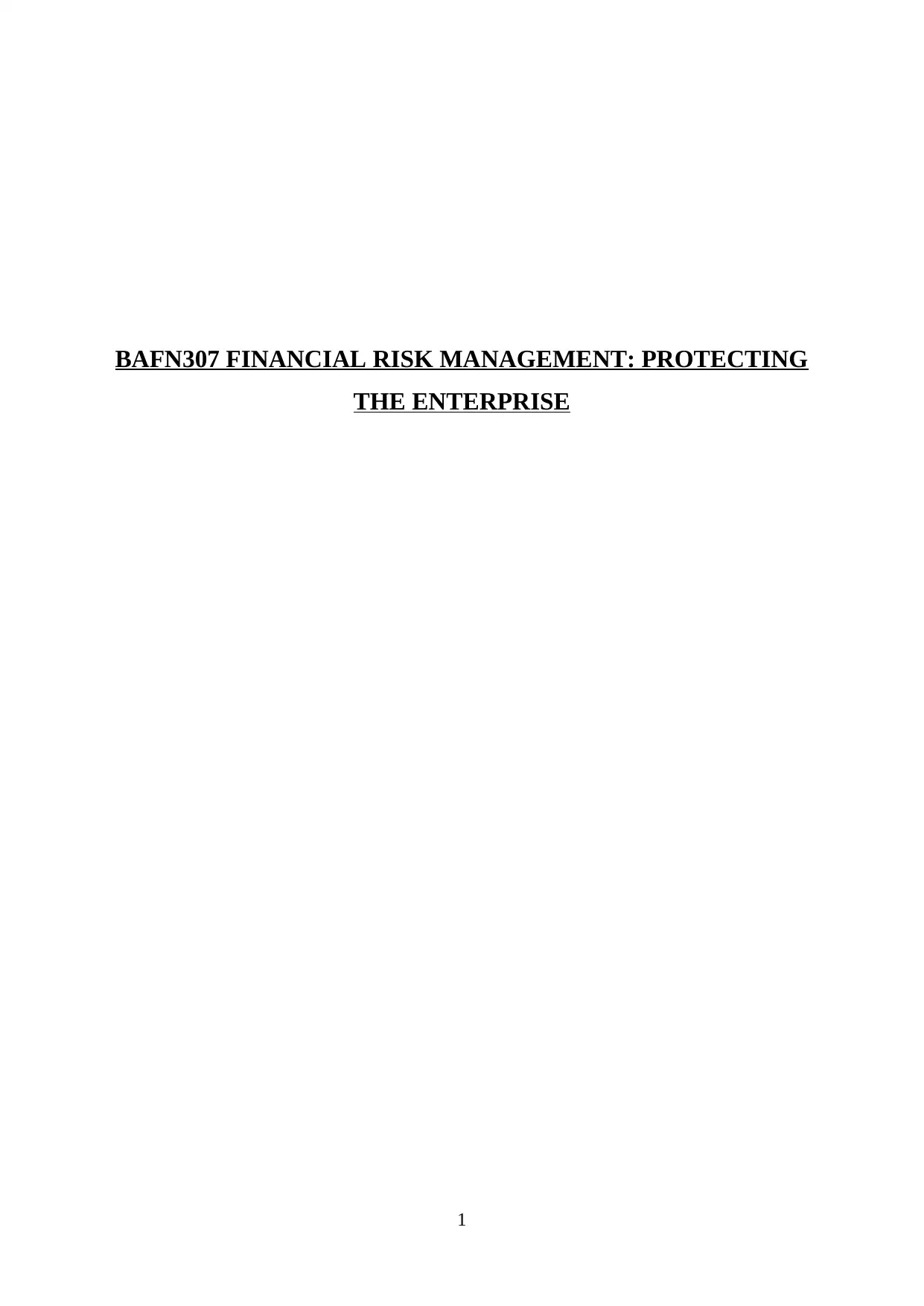
BAFN307 FINANCIAL RISK MANAGEMENT: PROTECTING
THE ENTERPRISE
1
THE ENTERPRISE
1
Paraphrase This Document
Need a fresh take? Get an instant paraphrase of this document with our AI Paraphraser
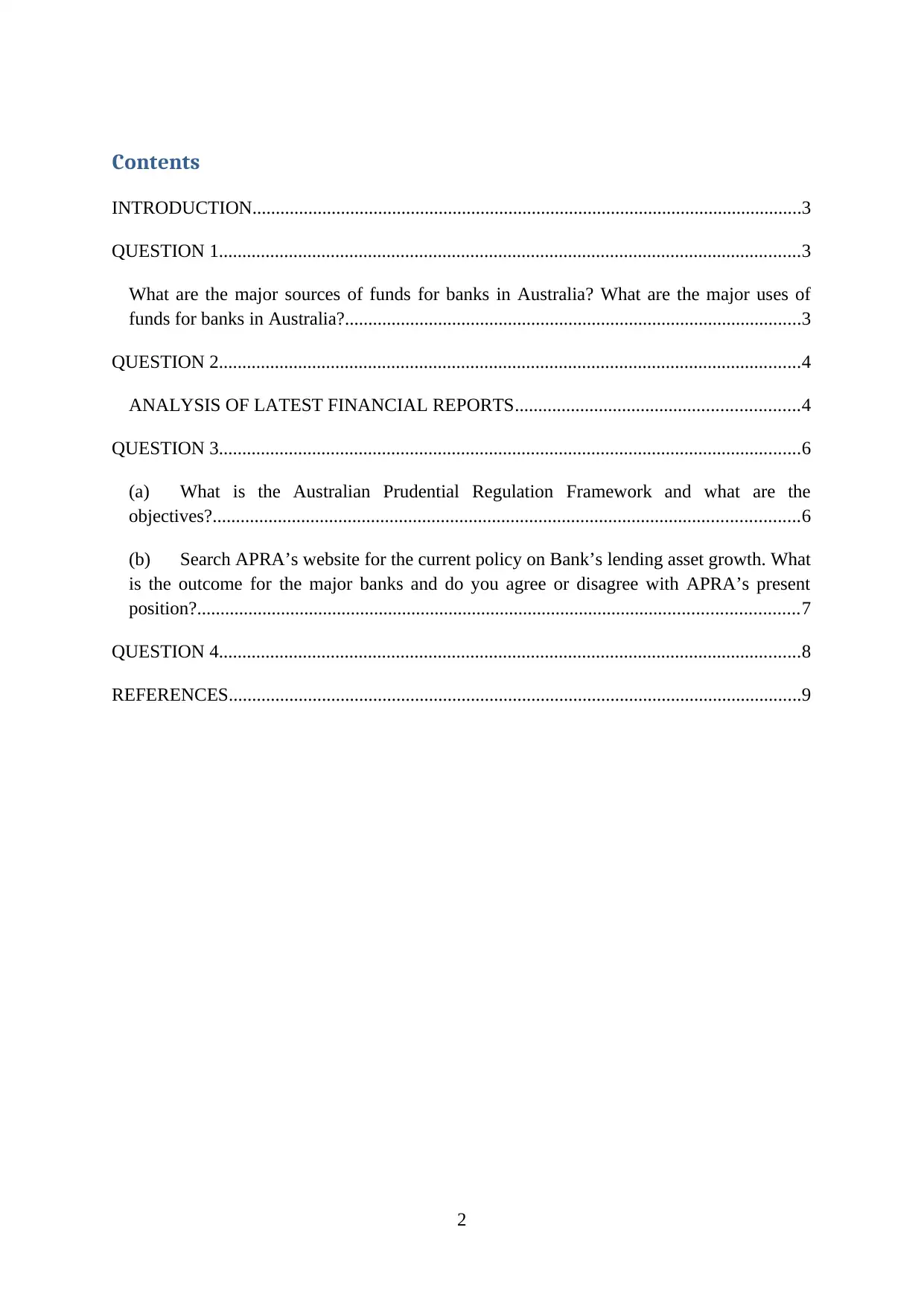
Contents
INTRODUCTION......................................................................................................................3
QUESTION 1.............................................................................................................................3
What are the major sources of funds for banks in Australia? What are the major uses of
funds for banks in Australia?..................................................................................................3
QUESTION 2.............................................................................................................................4
ANALYSIS OF LATEST FINANCIAL REPORTS.............................................................4
QUESTION 3.............................................................................................................................6
(a) What is the Australian Prudential Regulation Framework and what are the
objectives?..............................................................................................................................6
(b) Search APRA’s website for the current policy on Bank’s lending asset growth. What
is the outcome for the major banks and do you agree or disagree with APRA’s present
position?.................................................................................................................................7
QUESTION 4.............................................................................................................................8
REFERENCES...........................................................................................................................9
2
INTRODUCTION......................................................................................................................3
QUESTION 1.............................................................................................................................3
What are the major sources of funds for banks in Australia? What are the major uses of
funds for banks in Australia?..................................................................................................3
QUESTION 2.............................................................................................................................4
ANALYSIS OF LATEST FINANCIAL REPORTS.............................................................4
QUESTION 3.............................................................................................................................6
(a) What is the Australian Prudential Regulation Framework and what are the
objectives?..............................................................................................................................6
(b) Search APRA’s website for the current policy on Bank’s lending asset growth. What
is the outcome for the major banks and do you agree or disagree with APRA’s present
position?.................................................................................................................................7
QUESTION 4.............................................................................................................................8
REFERENCES...........................................................................................................................9
2

INTRODUCTION
Financial risk management is a management function wherein the entity tries to create
economic value with the use of financial instruments. These financial instruments are used by
the entity to manage the various exposures that the company faces from the different types of
risks being the operations risks, credit risks, market risks, foreign exchange risks, shape risks,
volatility risks, liquidity risks, and etc. In the current report, the financial analysis is done for
the four major banks of Australia being the Australia and New Zealand Banking Group
Limited, Commonwealth Bank of Australia, National Australia Bank, and Westpac Banking
Corporation. The first half year results for year 2018 are being analysed and results are
provided as follows (Bessis, 2015).
QUESTION 1
What are the major sources of funds for banks in Australia? What are the
major uses of funds for banks in Australia?
The financial results for the half year for financial year 2018 have been analysed for the
Commonwealth Bank of Australia to get an understanding of the carious sources from which
the bank is able to fulfil its fund requirements, and the ways it is utilising the same. the major
source of getting funds as evident from the financial reports tend to be the proceeds from the
issue of debt securities, issuance of loan capital, issue of share capital, dividend income from
shares purchased, proceeds from the sale of property, plant and equipment earlier invested in,
interest received on acquired investments, the premium and investment income on the
insurance product, proceeds from available-for-sale investments, proceeds from sale of
insurance assets at fair value, public borrowings and etc.
The major areas where these funds are being utilised are observed to be the interest payments,
the day to day expense payments, payment of income taxes, purchases of available-for-sale
investments, purchases of insurance assets, repayment of public borrowings, purchases of
property, plant, and equipment, payments for acquisition of investment, purchases of
intangible assets, payment of dividends, redemption of debt securities, purchase of treasury
shares, redemption of loan capital, and etc.
3
Financial risk management is a management function wherein the entity tries to create
economic value with the use of financial instruments. These financial instruments are used by
the entity to manage the various exposures that the company faces from the different types of
risks being the operations risks, credit risks, market risks, foreign exchange risks, shape risks,
volatility risks, liquidity risks, and etc. In the current report, the financial analysis is done for
the four major banks of Australia being the Australia and New Zealand Banking Group
Limited, Commonwealth Bank of Australia, National Australia Bank, and Westpac Banking
Corporation. The first half year results for year 2018 are being analysed and results are
provided as follows (Bessis, 2015).
QUESTION 1
What are the major sources of funds for banks in Australia? What are the
major uses of funds for banks in Australia?
The financial results for the half year for financial year 2018 have been analysed for the
Commonwealth Bank of Australia to get an understanding of the carious sources from which
the bank is able to fulfil its fund requirements, and the ways it is utilising the same. the major
source of getting funds as evident from the financial reports tend to be the proceeds from the
issue of debt securities, issuance of loan capital, issue of share capital, dividend income from
shares purchased, proceeds from the sale of property, plant and equipment earlier invested in,
interest received on acquired investments, the premium and investment income on the
insurance product, proceeds from available-for-sale investments, proceeds from sale of
insurance assets at fair value, public borrowings and etc.
The major areas where these funds are being utilised are observed to be the interest payments,
the day to day expense payments, payment of income taxes, purchases of available-for-sale
investments, purchases of insurance assets, repayment of public borrowings, purchases of
property, plant, and equipment, payments for acquisition of investment, purchases of
intangible assets, payment of dividends, redemption of debt securities, purchase of treasury
shares, redemption of loan capital, and etc.
3
⊘ This is a preview!⊘
Do you want full access?
Subscribe today to unlock all pages.

Trusted by 1+ million students worldwide
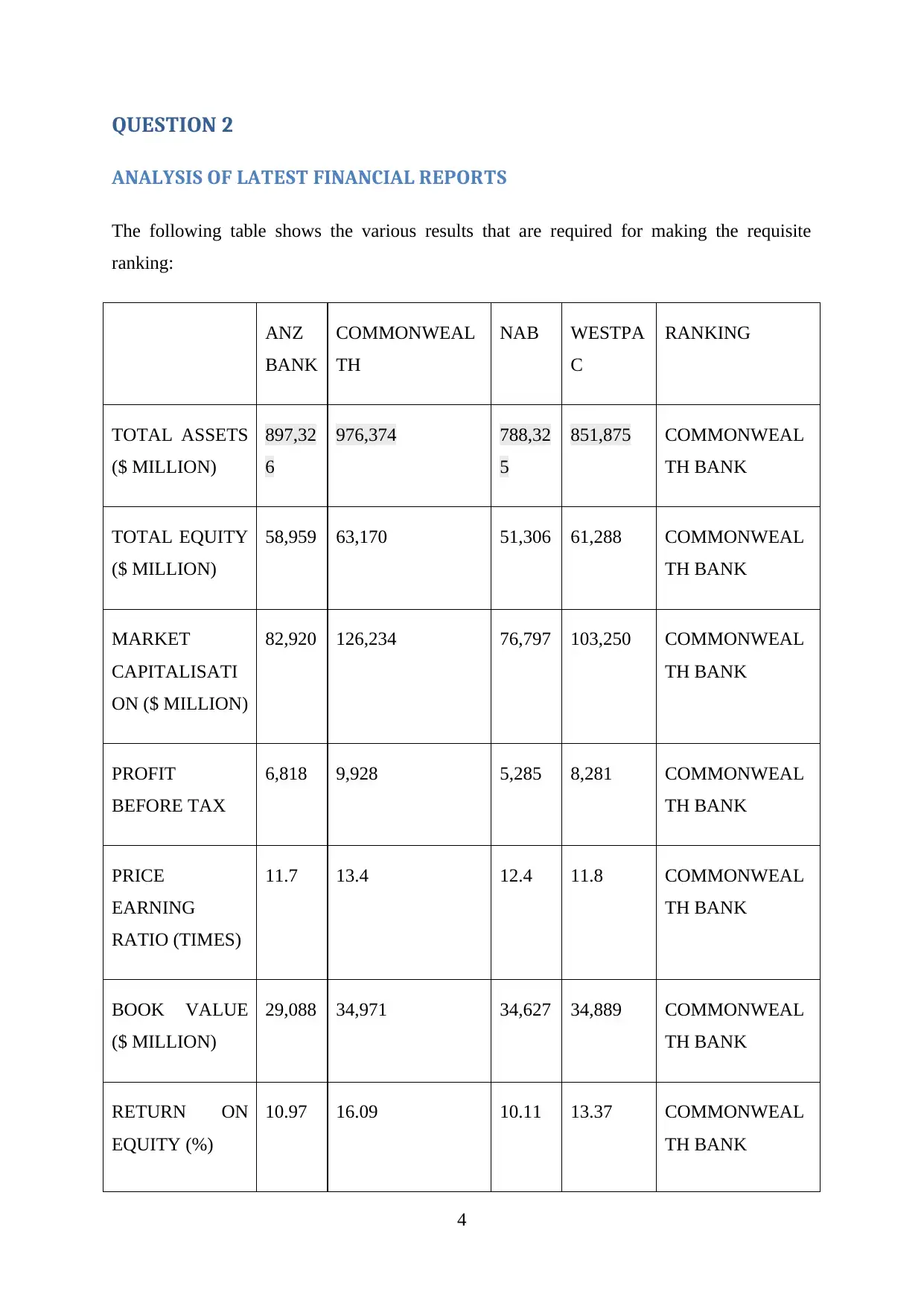
QUESTION 2
ANALYSIS OF LATEST FINANCIAL REPORTS
The following table shows the various results that are required for making the requisite
ranking:
ANZ
BANK
COMMONWEAL
TH
NAB WESTPA
C
RANKING
TOTAL ASSETS
($ MILLION)
897,32
6
976,374 788,32
5
851,875 COMMONWEAL
TH BANK
TOTAL EQUITY
($ MILLION)
58,959 63,170 51,306 61,288 COMMONWEAL
TH BANK
MARKET
CAPITALISATI
ON ($ MILLION)
82,920 126,234 76,797 103,250 COMMONWEAL
TH BANK
PROFIT
BEFORE TAX
6,818 9,928 5,285 8,281 COMMONWEAL
TH BANK
PRICE
EARNING
RATIO (TIMES)
11.7 13.4 12.4 11.8 COMMONWEAL
TH BANK
BOOK VALUE
($ MILLION)
29,088 34,971 34,627 34,889 COMMONWEAL
TH BANK
RETURN ON
EQUITY (%)
10.97 16.09 10.11 13.37 COMMONWEAL
TH BANK
4
ANALYSIS OF LATEST FINANCIAL REPORTS
The following table shows the various results that are required for making the requisite
ranking:
ANZ
BANK
COMMONWEAL
TH
NAB WESTPA
C
RANKING
TOTAL ASSETS
($ MILLION)
897,32
6
976,374 788,32
5
851,875 COMMONWEAL
TH BANK
TOTAL EQUITY
($ MILLION)
58,959 63,170 51,306 61,288 COMMONWEAL
TH BANK
MARKET
CAPITALISATI
ON ($ MILLION)
82,920 126,234 76,797 103,250 COMMONWEAL
TH BANK
PROFIT
BEFORE TAX
6,818 9,928 5,285 8,281 COMMONWEAL
TH BANK
PRICE
EARNING
RATIO (TIMES)
11.7 13.4 12.4 11.8 COMMONWEAL
TH BANK
BOOK VALUE
($ MILLION)
29,088 34,971 34,627 34,889 COMMONWEAL
TH BANK
RETURN ON
EQUITY (%)
10.97 16.09 10.11 13.37 COMMONWEAL
TH BANK
4
Paraphrase This Document
Need a fresh take? Get an instant paraphrase of this document with our AI Paraphraser
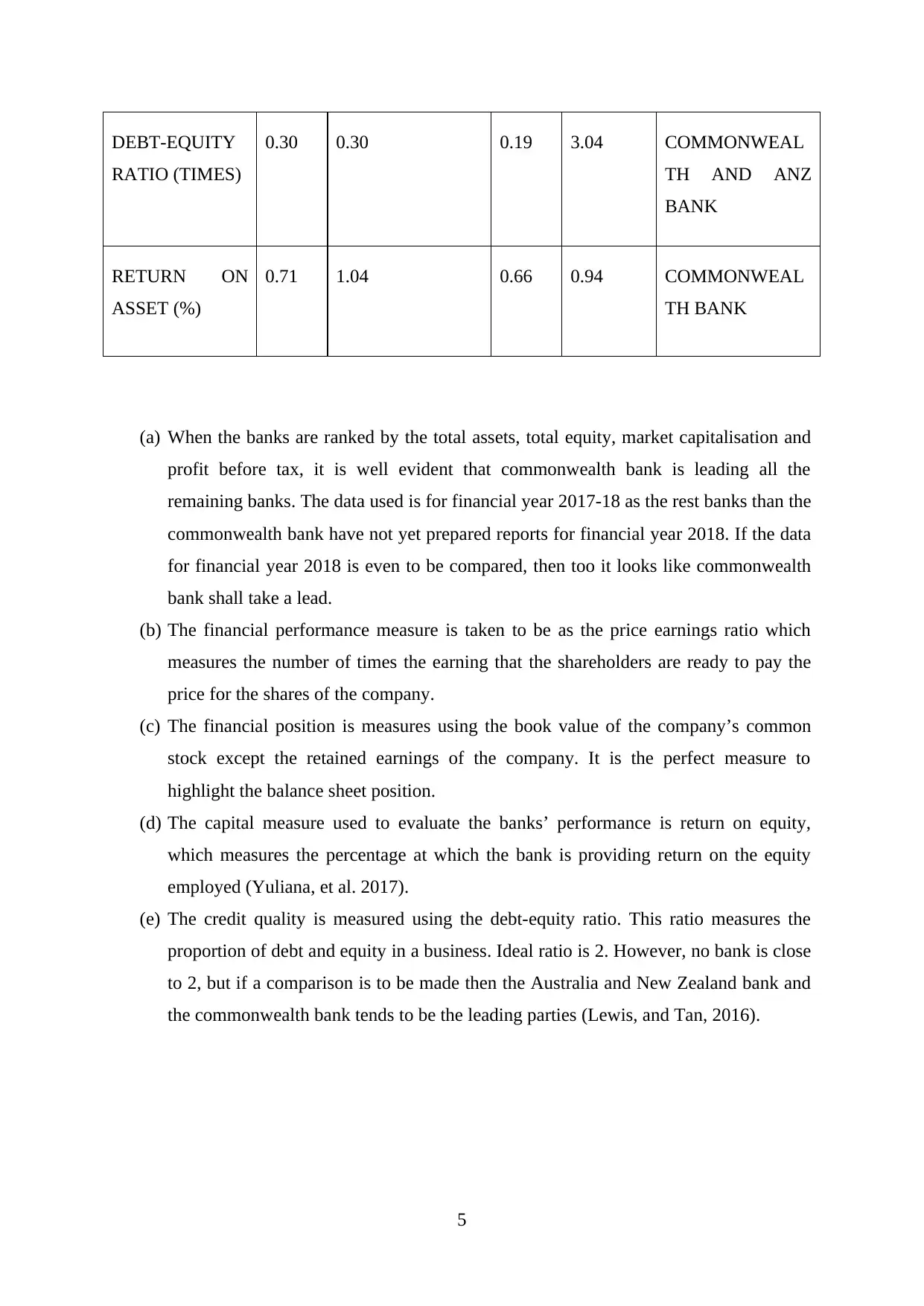
DEBT-EQUITY
RATIO (TIMES)
0.30 0.30 0.19 3.04 COMMONWEAL
TH AND ANZ
BANK
RETURN ON
ASSET (%)
0.71 1.04 0.66 0.94 COMMONWEAL
TH BANK
(a) When the banks are ranked by the total assets, total equity, market capitalisation and
profit before tax, it is well evident that commonwealth bank is leading all the
remaining banks. The data used is for financial year 2017-18 as the rest banks than the
commonwealth bank have not yet prepared reports for financial year 2018. If the data
for financial year 2018 is even to be compared, then too it looks like commonwealth
bank shall take a lead.
(b) The financial performance measure is taken to be as the price earnings ratio which
measures the number of times the earning that the shareholders are ready to pay the
price for the shares of the company.
(c) The financial position is measures using the book value of the company’s common
stock except the retained earnings of the company. It is the perfect measure to
highlight the balance sheet position.
(d) The capital measure used to evaluate the banks’ performance is return on equity,
which measures the percentage at which the bank is providing return on the equity
employed (Yuliana, et al. 2017).
(e) The credit quality is measured using the debt-equity ratio. This ratio measures the
proportion of debt and equity in a business. Ideal ratio is 2. However, no bank is close
to 2, but if a comparison is to be made then the Australia and New Zealand bank and
the commonwealth bank tends to be the leading parties (Lewis, and Tan, 2016).
5
RATIO (TIMES)
0.30 0.30 0.19 3.04 COMMONWEAL
TH AND ANZ
BANK
RETURN ON
ASSET (%)
0.71 1.04 0.66 0.94 COMMONWEAL
TH BANK
(a) When the banks are ranked by the total assets, total equity, market capitalisation and
profit before tax, it is well evident that commonwealth bank is leading all the
remaining banks. The data used is for financial year 2017-18 as the rest banks than the
commonwealth bank have not yet prepared reports for financial year 2018. If the data
for financial year 2018 is even to be compared, then too it looks like commonwealth
bank shall take a lead.
(b) The financial performance measure is taken to be as the price earnings ratio which
measures the number of times the earning that the shareholders are ready to pay the
price for the shares of the company.
(c) The financial position is measures using the book value of the company’s common
stock except the retained earnings of the company. It is the perfect measure to
highlight the balance sheet position.
(d) The capital measure used to evaluate the banks’ performance is return on equity,
which measures the percentage at which the bank is providing return on the equity
employed (Yuliana, et al. 2017).
(e) The credit quality is measured using the debt-equity ratio. This ratio measures the
proportion of debt and equity in a business. Ideal ratio is 2. However, no bank is close
to 2, but if a comparison is to be made then the Australia and New Zealand bank and
the commonwealth bank tends to be the leading parties (Lewis, and Tan, 2016).
5
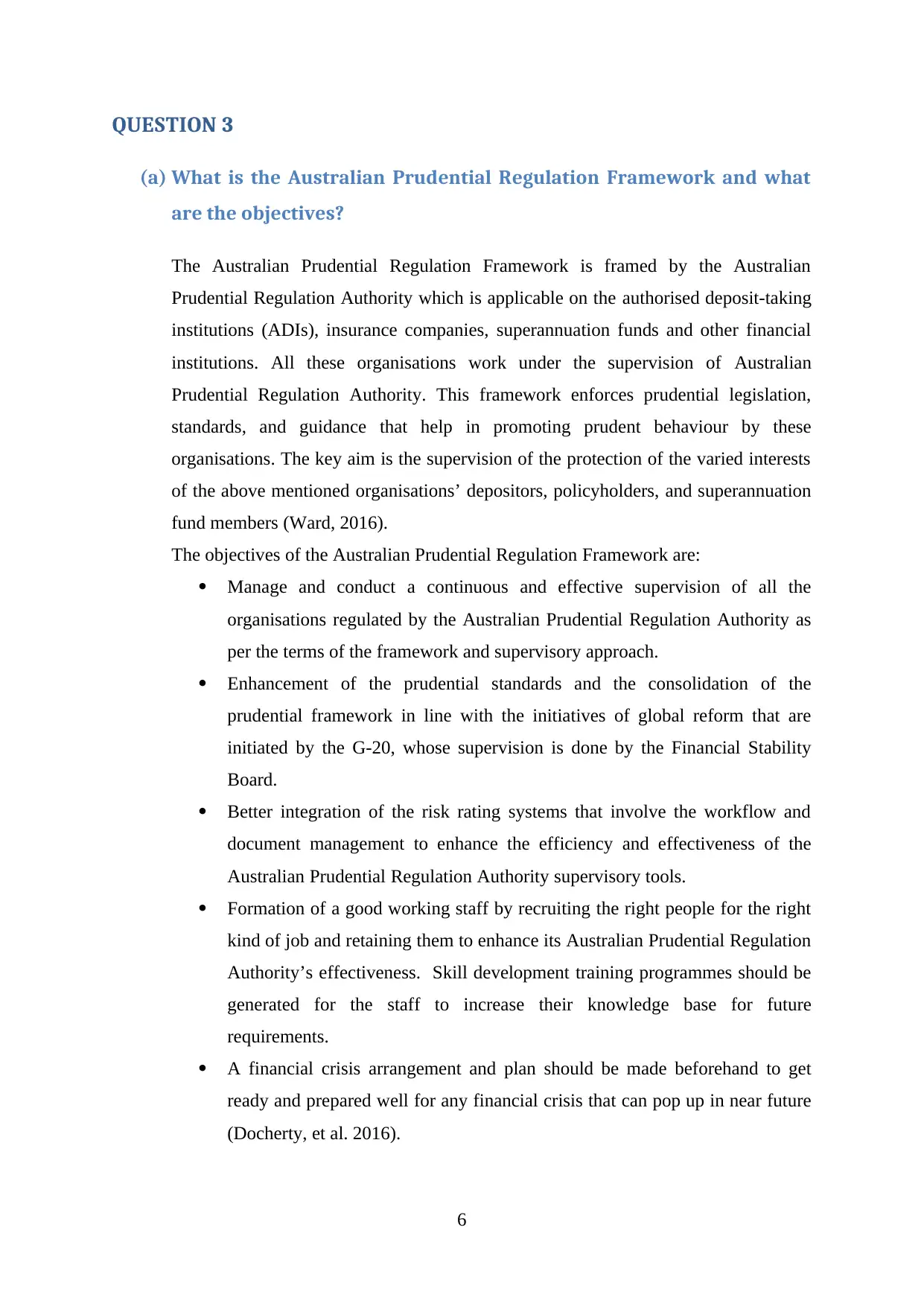
QUESTION 3
(a) What is the Australian Prudential Regulation Framework and what
are the objectives?
The Australian Prudential Regulation Framework is framed by the Australian
Prudential Regulation Authority which is applicable on the authorised deposit-taking
institutions (ADIs), insurance companies, superannuation funds and other financial
institutions. All these organisations work under the supervision of Australian
Prudential Regulation Authority. This framework enforces prudential legislation,
standards, and guidance that help in promoting prudent behaviour by these
organisations. The key aim is the supervision of the protection of the varied interests
of the above mentioned organisations’ depositors, policyholders, and superannuation
fund members (Ward, 2016).
The objectives of the Australian Prudential Regulation Framework are:
Manage and conduct a continuous and effective supervision of all the
organisations regulated by the Australian Prudential Regulation Authority as
per the terms of the framework and supervisory approach.
Enhancement of the prudential standards and the consolidation of the
prudential framework in line with the initiatives of global reform that are
initiated by the G-20, whose supervision is done by the Financial Stability
Board.
Better integration of the risk rating systems that involve the workflow and
document management to enhance the efficiency and effectiveness of the
Australian Prudential Regulation Authority supervisory tools.
Formation of a good working staff by recruiting the right people for the right
kind of job and retaining them to enhance its Australian Prudential Regulation
Authority’s effectiveness. Skill development training programmes should be
generated for the staff to increase their knowledge base for future
requirements.
A financial crisis arrangement and plan should be made beforehand to get
ready and prepared well for any financial crisis that can pop up in near future
(Docherty, et al. 2016).
6
(a) What is the Australian Prudential Regulation Framework and what
are the objectives?
The Australian Prudential Regulation Framework is framed by the Australian
Prudential Regulation Authority which is applicable on the authorised deposit-taking
institutions (ADIs), insurance companies, superannuation funds and other financial
institutions. All these organisations work under the supervision of Australian
Prudential Regulation Authority. This framework enforces prudential legislation,
standards, and guidance that help in promoting prudent behaviour by these
organisations. The key aim is the supervision of the protection of the varied interests
of the above mentioned organisations’ depositors, policyholders, and superannuation
fund members (Ward, 2016).
The objectives of the Australian Prudential Regulation Framework are:
Manage and conduct a continuous and effective supervision of all the
organisations regulated by the Australian Prudential Regulation Authority as
per the terms of the framework and supervisory approach.
Enhancement of the prudential standards and the consolidation of the
prudential framework in line with the initiatives of global reform that are
initiated by the G-20, whose supervision is done by the Financial Stability
Board.
Better integration of the risk rating systems that involve the workflow and
document management to enhance the efficiency and effectiveness of the
Australian Prudential Regulation Authority supervisory tools.
Formation of a good working staff by recruiting the right people for the right
kind of job and retaining them to enhance its Australian Prudential Regulation
Authority’s effectiveness. Skill development training programmes should be
generated for the staff to increase their knowledge base for future
requirements.
A financial crisis arrangement and plan should be made beforehand to get
ready and prepared well for any financial crisis that can pop up in near future
(Docherty, et al. 2016).
6
⊘ This is a preview!⊘
Do you want full access?
Subscribe today to unlock all pages.

Trusted by 1+ million students worldwide
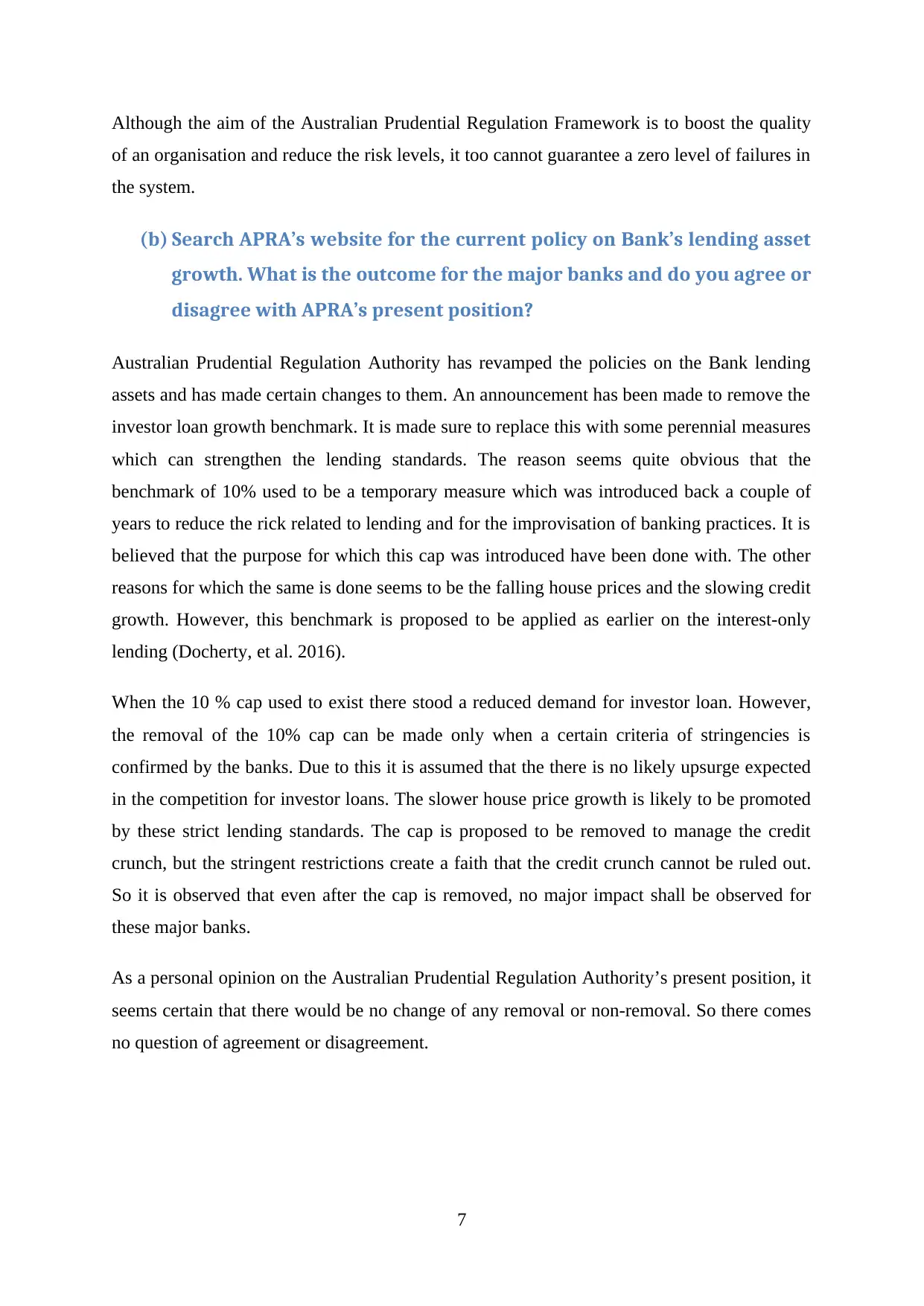
Although the aim of the Australian Prudential Regulation Framework is to boost the quality
of an organisation and reduce the risk levels, it too cannot guarantee a zero level of failures in
the system.
(b) Search APRA’s website for the current policy on Bank’s lending asset
growth. What is the outcome for the major banks and do you agree or
disagree with APRA’s present position?
Australian Prudential Regulation Authority has revamped the policies on the Bank lending
assets and has made certain changes to them. An announcement has been made to remove the
investor loan growth benchmark. It is made sure to replace this with some perennial measures
which can strengthen the lending standards. The reason seems quite obvious that the
benchmark of 10% used to be a temporary measure which was introduced back a couple of
years to reduce the rick related to lending and for the improvisation of banking practices. It is
believed that the purpose for which this cap was introduced have been done with. The other
reasons for which the same is done seems to be the falling house prices and the slowing credit
growth. However, this benchmark is proposed to be applied as earlier on the interest-only
lending (Docherty, et al. 2016).
When the 10 % cap used to exist there stood a reduced demand for investor loan. However,
the removal of the 10% cap can be made only when a certain criteria of stringencies is
confirmed by the banks. Due to this it is assumed that the there is no likely upsurge expected
in the competition for investor loans. The slower house price growth is likely to be promoted
by these strict lending standards. The cap is proposed to be removed to manage the credit
crunch, but the stringent restrictions create a faith that the credit crunch cannot be ruled out.
So it is observed that even after the cap is removed, no major impact shall be observed for
these major banks.
As a personal opinion on the Australian Prudential Regulation Authority’s present position, it
seems certain that there would be no change of any removal or non-removal. So there comes
no question of agreement or disagreement.
7
of an organisation and reduce the risk levels, it too cannot guarantee a zero level of failures in
the system.
(b) Search APRA’s website for the current policy on Bank’s lending asset
growth. What is the outcome for the major banks and do you agree or
disagree with APRA’s present position?
Australian Prudential Regulation Authority has revamped the policies on the Bank lending
assets and has made certain changes to them. An announcement has been made to remove the
investor loan growth benchmark. It is made sure to replace this with some perennial measures
which can strengthen the lending standards. The reason seems quite obvious that the
benchmark of 10% used to be a temporary measure which was introduced back a couple of
years to reduce the rick related to lending and for the improvisation of banking practices. It is
believed that the purpose for which this cap was introduced have been done with. The other
reasons for which the same is done seems to be the falling house prices and the slowing credit
growth. However, this benchmark is proposed to be applied as earlier on the interest-only
lending (Docherty, et al. 2016).
When the 10 % cap used to exist there stood a reduced demand for investor loan. However,
the removal of the 10% cap can be made only when a certain criteria of stringencies is
confirmed by the banks. Due to this it is assumed that the there is no likely upsurge expected
in the competition for investor loans. The slower house price growth is likely to be promoted
by these strict lending standards. The cap is proposed to be removed to manage the credit
crunch, but the stringent restrictions create a faith that the credit crunch cannot be ruled out.
So it is observed that even after the cap is removed, no major impact shall be observed for
these major banks.
As a personal opinion on the Australian Prudential Regulation Authority’s present position, it
seems certain that there would be no change of any removal or non-removal. So there comes
no question of agreement or disagreement.
7
Paraphrase This Document
Need a fresh take? Get an instant paraphrase of this document with our AI Paraphraser
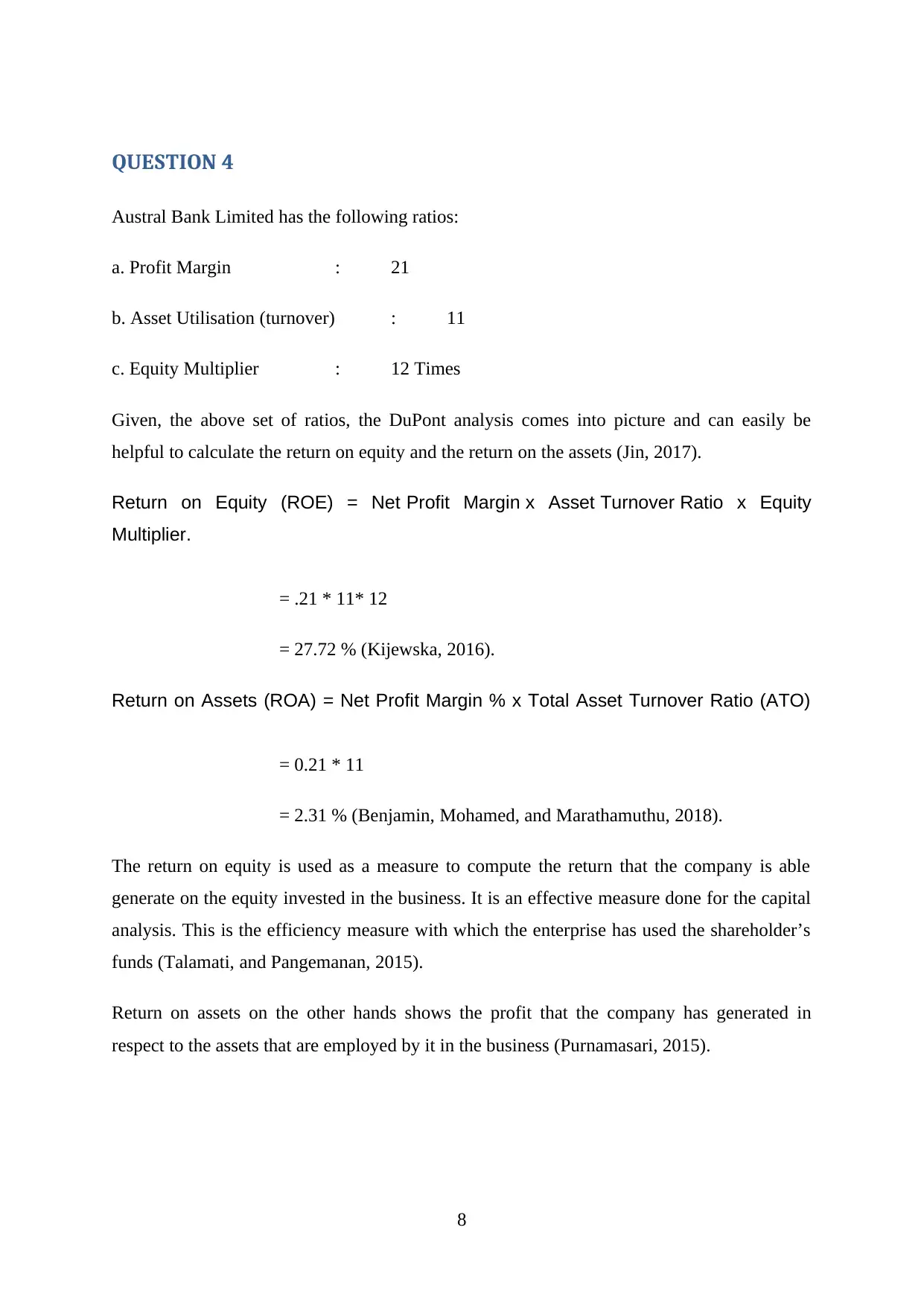
QUESTION 4
Austral Bank Limited has the following ratios:
a. Profit Margin : 21
b. Asset Utilisation (turnover) : 11
c. Equity Multiplier : 12 Times
Given, the above set of ratios, the DuPont analysis comes into picture and can easily be
helpful to calculate the return on equity and the return on the assets (Jin, 2017).
Return on Equity (ROE) = Net Profit Margin x Asset Turnover Ratio x Equity
Multiplier.
= .21 * 11* 12
= 27.72 % (Kijewska, 2016).
Return on Assets (ROA) = Net Profit Margin % x Total Asset Turnover Ratio (ATO)
= 0.21 * 11
= 2.31 % (Benjamin, Mohamed, and Marathamuthu, 2018).
The return on equity is used as a measure to compute the return that the company is able
generate on the equity invested in the business. It is an effective measure done for the capital
analysis. This is the efficiency measure with which the enterprise has used the shareholder’s
funds (Talamati, and Pangemanan, 2015).
Return on assets on the other hands shows the profit that the company has generated in
respect to the assets that are employed by it in the business (Purnamasari, 2015).
8
Austral Bank Limited has the following ratios:
a. Profit Margin : 21
b. Asset Utilisation (turnover) : 11
c. Equity Multiplier : 12 Times
Given, the above set of ratios, the DuPont analysis comes into picture and can easily be
helpful to calculate the return on equity and the return on the assets (Jin, 2017).
Return on Equity (ROE) = Net Profit Margin x Asset Turnover Ratio x Equity
Multiplier.
= .21 * 11* 12
= 27.72 % (Kijewska, 2016).
Return on Assets (ROA) = Net Profit Margin % x Total Asset Turnover Ratio (ATO)
= 0.21 * 11
= 2.31 % (Benjamin, Mohamed, and Marathamuthu, 2018).
The return on equity is used as a measure to compute the return that the company is able
generate on the equity invested in the business. It is an effective measure done for the capital
analysis. This is the efficiency measure with which the enterprise has used the shareholder’s
funds (Talamati, and Pangemanan, 2015).
Return on assets on the other hands shows the profit that the company has generated in
respect to the assets that are employed by it in the business (Purnamasari, 2015).
8
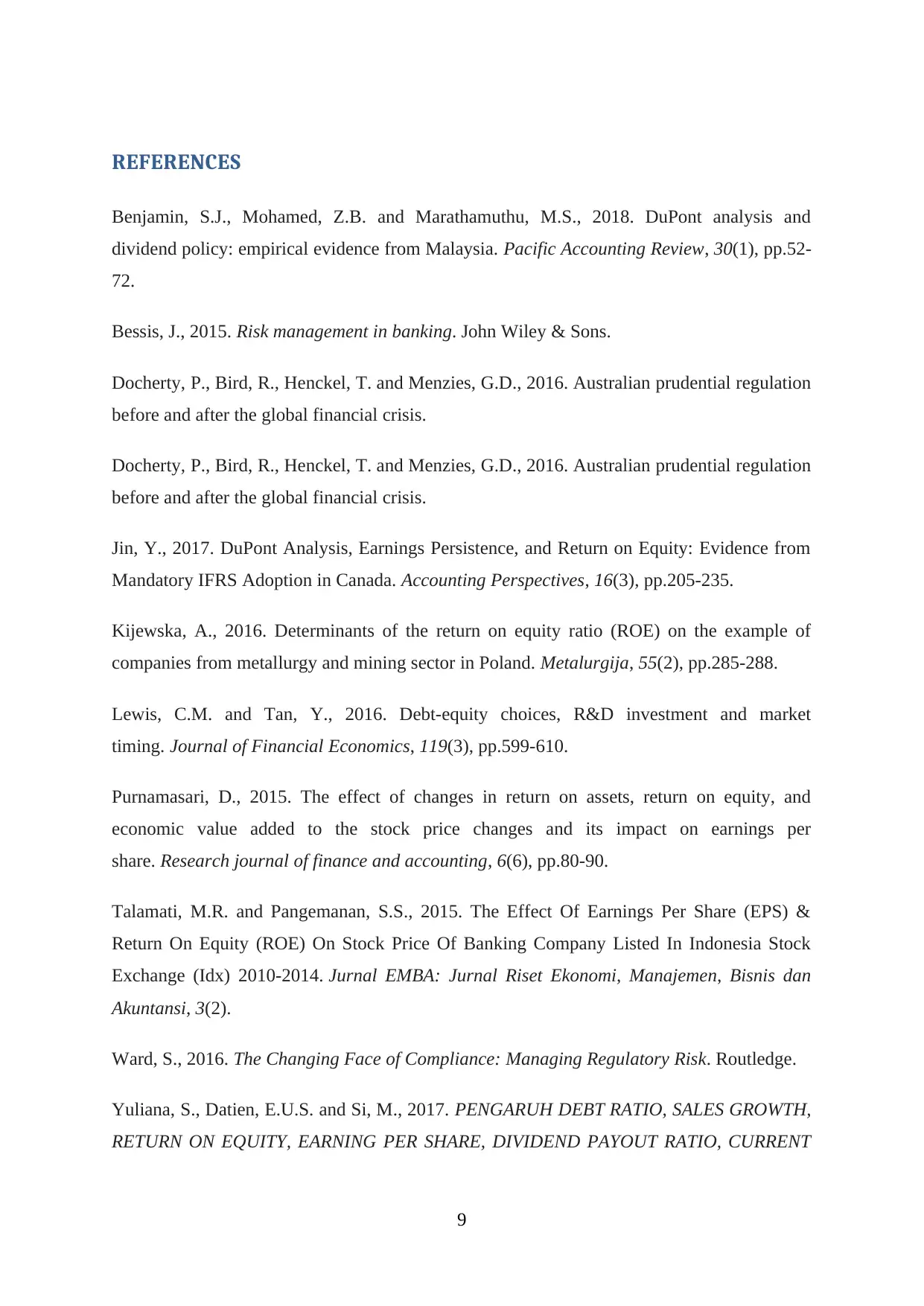
REFERENCES
Benjamin, S.J., Mohamed, Z.B. and Marathamuthu, M.S., 2018. DuPont analysis and
dividend policy: empirical evidence from Malaysia. Pacific Accounting Review, 30(1), pp.52-
72.
Bessis, J., 2015. Risk management in banking. John Wiley & Sons.
Docherty, P., Bird, R., Henckel, T. and Menzies, G.D., 2016. Australian prudential regulation
before and after the global financial crisis.
Docherty, P., Bird, R., Henckel, T. and Menzies, G.D., 2016. Australian prudential regulation
before and after the global financial crisis.
Jin, Y., 2017. DuPont Analysis, Earnings Persistence, and Return on Equity: Evidence from
Mandatory IFRS Adoption in Canada. Accounting Perspectives, 16(3), pp.205-235.
Kijewska, A., 2016. Determinants of the return on equity ratio (ROE) on the example of
companies from metallurgy and mining sector in Poland. Metalurgija, 55(2), pp.285-288.
Lewis, C.M. and Tan, Y., 2016. Debt-equity choices, R&D investment and market
timing. Journal of Financial Economics, 119(3), pp.599-610.
Purnamasari, D., 2015. The effect of changes in return on assets, return on equity, and
economic value added to the stock price changes and its impact on earnings per
share. Research journal of finance and accounting, 6(6), pp.80-90.
Talamati, M.R. and Pangemanan, S.S., 2015. The Effect Of Earnings Per Share (EPS) &
Return On Equity (ROE) On Stock Price Of Banking Company Listed In Indonesia Stock
Exchange (Idx) 2010-2014. Jurnal EMBA: Jurnal Riset Ekonomi, Manajemen, Bisnis dan
Akuntansi, 3(2).
Ward, S., 2016. The Changing Face of Compliance: Managing Regulatory Risk. Routledge.
Yuliana, S., Datien, E.U.S. and Si, M., 2017. PENGARUH DEBT RATIO, SALES GROWTH,
RETURN ON EQUITY, EARNING PER SHARE, DIVIDEND PAYOUT RATIO, CURRENT
9
Benjamin, S.J., Mohamed, Z.B. and Marathamuthu, M.S., 2018. DuPont analysis and
dividend policy: empirical evidence from Malaysia. Pacific Accounting Review, 30(1), pp.52-
72.
Bessis, J., 2015. Risk management in banking. John Wiley & Sons.
Docherty, P., Bird, R., Henckel, T. and Menzies, G.D., 2016. Australian prudential regulation
before and after the global financial crisis.
Docherty, P., Bird, R., Henckel, T. and Menzies, G.D., 2016. Australian prudential regulation
before and after the global financial crisis.
Jin, Y., 2017. DuPont Analysis, Earnings Persistence, and Return on Equity: Evidence from
Mandatory IFRS Adoption in Canada. Accounting Perspectives, 16(3), pp.205-235.
Kijewska, A., 2016. Determinants of the return on equity ratio (ROE) on the example of
companies from metallurgy and mining sector in Poland. Metalurgija, 55(2), pp.285-288.
Lewis, C.M. and Tan, Y., 2016. Debt-equity choices, R&D investment and market
timing. Journal of Financial Economics, 119(3), pp.599-610.
Purnamasari, D., 2015. The effect of changes in return on assets, return on equity, and
economic value added to the stock price changes and its impact on earnings per
share. Research journal of finance and accounting, 6(6), pp.80-90.
Talamati, M.R. and Pangemanan, S.S., 2015. The Effect Of Earnings Per Share (EPS) &
Return On Equity (ROE) On Stock Price Of Banking Company Listed In Indonesia Stock
Exchange (Idx) 2010-2014. Jurnal EMBA: Jurnal Riset Ekonomi, Manajemen, Bisnis dan
Akuntansi, 3(2).
Ward, S., 2016. The Changing Face of Compliance: Managing Regulatory Risk. Routledge.
Yuliana, S., Datien, E.U.S. and Si, M., 2017. PENGARUH DEBT RATIO, SALES GROWTH,
RETURN ON EQUITY, EARNING PER SHARE, DIVIDEND PAYOUT RATIO, CURRENT
9
⊘ This is a preview!⊘
Do you want full access?
Subscribe today to unlock all pages.

Trusted by 1+ million students worldwide
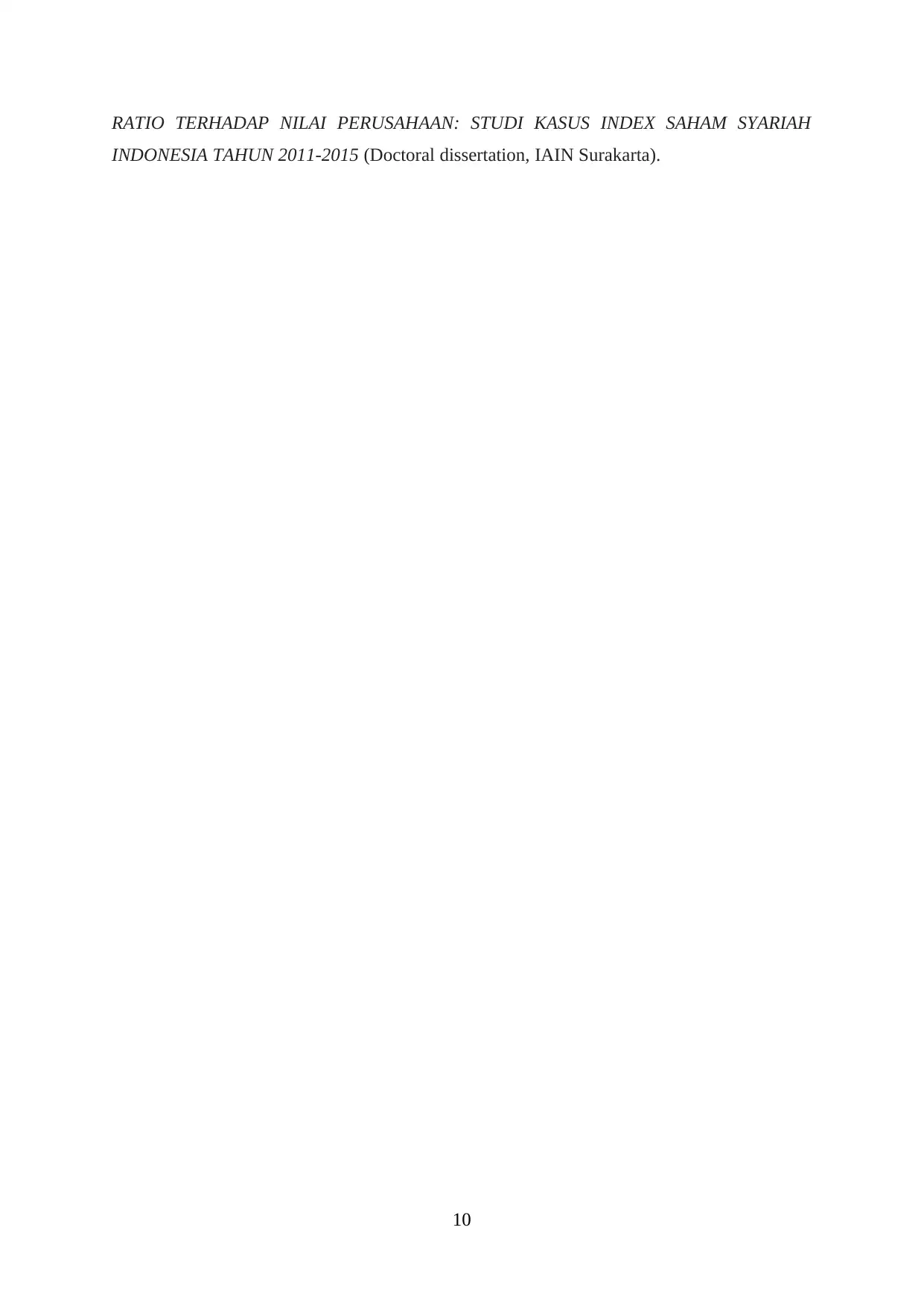
RATIO TERHADAP NILAI PERUSAHAAN: STUDI KASUS INDEX SAHAM SYARIAH
INDONESIA TAHUN 2011-2015 (Doctoral dissertation, IAIN Surakarta).
10
INDONESIA TAHUN 2011-2015 (Doctoral dissertation, IAIN Surakarta).
10
1 out of 10
Related Documents
Your All-in-One AI-Powered Toolkit for Academic Success.
+13062052269
info@desklib.com
Available 24*7 on WhatsApp / Email
![[object Object]](/_next/static/media/star-bottom.7253800d.svg)
Unlock your academic potential
Copyright © 2020–2026 A2Z Services. All Rights Reserved. Developed and managed by ZUCOL.





